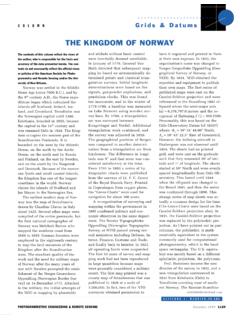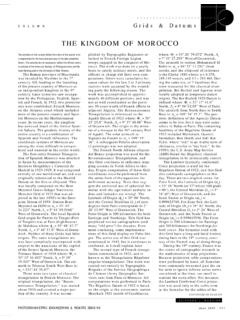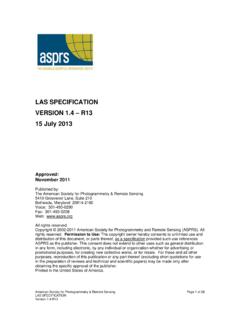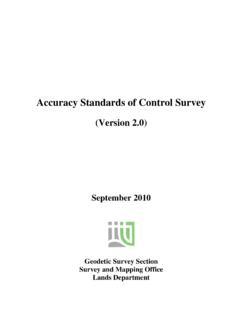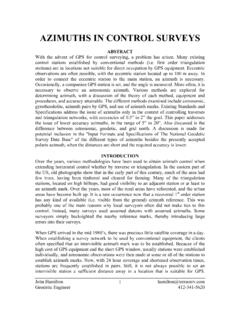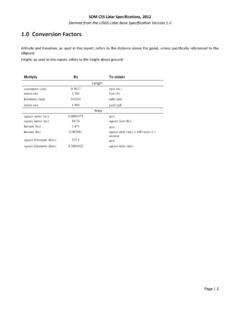Transcription of ASPRS Positional Accuracy Standards for Digital …
1 ASPRS Positional Accuracy Standards for Digital Geospatial Data (EDITION 1, VERSION - NOVEMBER, 2014). 1. Scope and Applicability ..A3. Structure and 2. 3. 4. 5. Terms and 6. Symbols, Abbreviated Terms, and 7. Specific Statistical Assessment of Horizontal and Vertical Assumptions Regarding Systematic Errors and Acceptable Mean Horizontal Accuracy Standards for Geospatial Vertical Accuracy Standards for Elevation Horizontal Accuracy Requirements for Elevation Low Confidence Areas for Elevation Accuracy Requirements for Aerial Triangulation and INS-based Sensor Orientation of Digital Accuracy Requirements for Ground Control Used for Aerial Checkpoint Accuracy and Placement Checkpoint Density and Relative Accuracy of Lidar and IFSAR Photogrammetric Engineering &
2 Remote Sensing Vol. 81, No. 3, March 2015, pp. A1 A26. 0099-1112/15/813 A1. 2014 American Society for Photogrammetry and Remote Sensing doi: PHOTOGRAMMETRIC ENGINEERING & REMOTE SENSING Ma rch 2015 A1. ANNEX A - BACKGROUND AND JUSTIFICATIONS (INFORMATIVE)..A10. Legacy Standards and New Standard for a New A11. Mapping Practices During the Film-based A11. Mapping Practices During the Softcopy Photogrammetry A11. Mapping Practices during the Digital Sensors Photogrammetry ANNEX B DATA Accuracy AND QUALITY EXAMPLES (NORMATIVE)..A12. Aerial Triangulation and Ground Control Accuracy Digital Orthoimagery Horizontal Accuracy Digital Planimetric Data Horizontal Accuracy Digital Elevation Data Vertical Accuracy Converting ASPRS 2014 Accuracy Values to Legacy ASPRS 1990 Accuracy Converting ASPRS 2014 Accuracy Values to Legacy NMAS 1947 Accuracy Expressing the ASPRS 2014 Accuracy Values According to the FGDC National Standard for Spatial Data Accuracy (NSSDA).
3 A17. Horizontal Accuracy Examples for Lidar Elevation Data Accuracy versus Elevation Data ANNEX C - Accuracy TESTING AND REPORTING GUIDELINES (NORMATIVE)..A19. Checkpoint Number of Checkpoints Distribution of Vertical Checkpoints across Land Cover NSSDA Methodology for Checkpoint Distribution (Horizontal and Vertical Testing)..A20. Vertical Checkpoint Testing and Reporting of Horizontal Testing and Reporting of Vertical Low Confidence Erroneous Relative Accuracy Comparison Point Location and Criteria for Lidar Swath-to-Swath Accuracy Interpolation of Elevation Represented Surface for Checkpoint ANNEX D Accuracy STATISTICS AND EXAMPLE (NORMATIVE).
4 A23. NSSDA Reporting Accuracy Comparison with NDEP Vertical Accuracy Computation of A2 M a rch 2 015 PHOTOGRAMMETRIC ENGINEERING & REMOTE SENSING. FOREWORD. The goal of American Society for Photogrammetry and Remote Sens- This standard was developed by the ASPRS Map Accuracy Stan- ing ( ASPRS ) is to advance the science of photogrammetry and remote dards Working Group, a joint committee under the Photogrammetric sensing; to educate individuals in the science of photogrammetry and Applications Division, Primary Data Acquisition Division, and Lidar remote sensing.
5 To foster the exchange of information pertaining to the Division, which was formed for the purpose of reviewing and updating science of photogrammetry and remote sensing; to develop, place into ASPRS map Accuracy Standards to reflect current technologies. A sub- practice, and maintain Standards and ethics applicable to aspects of the committee of this group, consisting of Dr. Qassim Abdullah of Wool- science; to provide a means for the exchange of ideas among those in- pert, Inc., Dr. David Maune of Dewberry Consultants, Doug Smith of terested in the sciences; and to encourage, publish and distribute books, David C.
6 Smith and Associates, Inc., and Hans Karl Heidemann of the periodicals, treatises, and other scholarly and practical works to further Geological Survey, was responsible for drafting the document. the science of photogrammetry and remote sensing. ASPRS Positional Accuracy Standards . FOR Digital GEOSPATIAL DATA. 1. PURPOSE. The objective of the ASPRS Positional Accuracy Standards for Digital 1. Methodologies for Accuracy assessment of linear features (as Geospatial Data is to replace the existing ASPRS Accuracy Standards opposed to well defined points);. for Large-Scale Maps (1990), and the ASPRS Guidelines, Vertical 2.
7 Rigorous total propagated uncertainty (TPU) modeling (as op- Accuracy Reporting for Lidar Data (2004) to better address current posed to or in addition to ground truthing against indepen- technologies. dent data sources);. This standard includes Positional Accuracy Standards for Digital 3. Robust statistics for data sets that do not meet the criteria for orthoimagery, Digital planimetric data and Digital elevation data. Accu- normally distributed data and therefore cannot be rigorously racy classes, based on RMSE values, have been revised and upgraded assessed using the statistical methods specified herein.
8 From the 1990 standard to address the higher accuracies achievable 4. Image quality factors, such as edge definition and other charac- with newer technologies. The standard also includes additional accura- teristics;. cy measures, such as orthoimagery seam lines, aerial triangulation ac- 5. Robust assessment of checkpoint distribution and density;. curacy, lidar relative swath-to-swath Accuracy , recommended minimum 6. Alternate methodologies to TIN interpolation for vertical ac- Nominal Pulse Density (NPD), horizontal Accuracy of elevation data, curacy assessment.
9 Delineation of low confidence areas for vertical data, and the required This standard is intended to be the initial component upon which number and spatial distribution of checkpoints based on project area. future work can build. Additional supplemental Standards or modules should be pursued and added by subject matter experts in these fields Scope and Applicability as they are developed and approved by the ASPRS . At this time this standard does not reference existing international This standard addresses geo-location accuracies of geospatial products Standards .
10 International Standards could be addressed in future mod- and it is not intended to cover classification Accuracy of thematic maps. ules or versions of this standard if needed. Further, the standard does not specify the best practices or methodolo- gies needed to meet the Accuracy thresholds stated herein. Specific Structure and Format requirements for the testing methodologies are specified as are some of the key elemental steps that are critical to the development of data The standard is structured as follows: The primary terms and definitions, if they are to meet these Standards .


